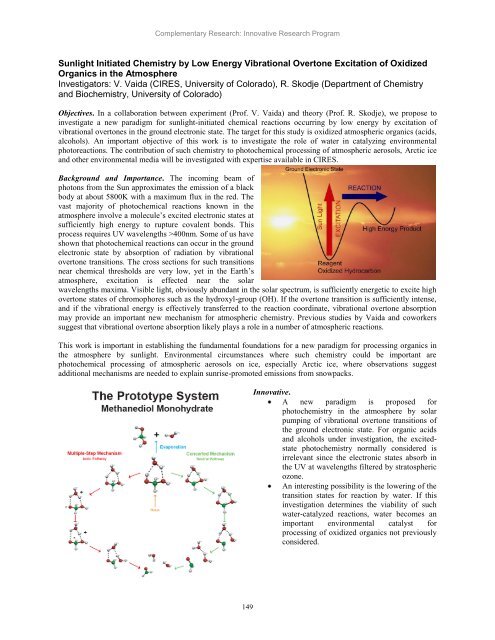Scientific Theme: Advanced Modeling and Observing Systems
Scientific Theme: Advanced Modeling and Observing Systems
Scientific Theme: Advanced Modeling and Observing Systems
Create successful ePaper yourself
Turn your PDF publications into a flip-book with our unique Google optimized e-Paper software.
Complementary Research: Innovative Research Program<br />
Sunlight Initiated Chemistry by Low Energy Vibrational Overtone Excitation of Oxidized<br />
Organics in the Atmosphere<br />
Investigators: V. Vaida (CIRES, University of Colorado), R. Skodje (Department of Chemistry<br />
<strong>and</strong> Biochemistry, University of Colorado)<br />
Objectives. In a collaboration between experiment (Prof. V. Vaida) <strong>and</strong> theory (Prof. R. Skodje), we propose to<br />
investigate a new paradigm for sunlight-initiated chemical reactions occurring by low energy by excitation of<br />
vibrational overtones in the ground electronic state. The target for this study is oxidized atmospheric organics (acids,<br />
alcohols). An important objective of this work is to investigate the role of water in catalyzing environmental<br />
photoreactions. The contribution of such chemistry to photochemical processing of atmospheric aerosols, Arctic ice<br />
<strong>and</strong> other environmental media will be investigated with expertise available in CIRES.<br />
Background <strong>and</strong> Importance. The incoming beam of<br />
photons from the Sun approximates the emission of a black<br />
body at about 5800K with a maximum flux in the red. The<br />
vast majority of photochemical reactions known in the<br />
atmosphere involve a molecule‘s excited electronic states at<br />
sufficiently high energy to rupture covalent bonds. This<br />
process requires UV wavelengths >400nm. Some of us have<br />
shown that photochemical reactions can occur in the ground<br />
electronic state by absorption of radiation by vibrational<br />
overtone transitions. The cross sections for such transitions<br />
near chemical thresholds are very low, yet in the Earth‘s<br />
atmosphere, excitation is effected near the solar<br />
wavelengths maxima. Visible light, obviously abundant in the solar spectrum, is sufficiently energetic to excite high<br />
overtone states of chromophores such as the hydroxyl-group (OH). If the overtone transition is sufficiently intense,<br />
<strong>and</strong> if the vibrational energy is effectively transferred to the reaction coordinate, vibrational overtone absorption<br />
may provide an important new mechanism for atmospheric chemistry. Previous studies by Vaida <strong>and</strong> coworkers<br />
suggest that vibrational overtone absorption likely plays a role in a number of atmospheric reactions.<br />
This work is important in establishing the fundamental foundations for a new paradigm for processing organics in<br />
the atmosphere by sunlight. Environmental circumstances where such chemistry could be important are<br />
photochemical processing of atmospheric aerosols on ice, especially Arctic ice, where observations suggest<br />
additional mechanisms are needed to explain sunrise-promoted emissions from snowpacks.<br />
149<br />
Innovative.<br />
A new paradigm is proposed for<br />
photochemistry in the atmosphere by solar<br />
pumping of vibrational overtone transitions of<br />
the ground electronic state. For organic acids<br />
<strong>and</strong> alcohols under investigation, the excitedstate<br />
photochemistry normally considered is<br />
irrelevant since the electronic states absorb in<br />
the UV at wavelengths filtered by stratospheric<br />
ozone.<br />
An interesting possibility is the lowering of the<br />
transition states for reaction by water. If this<br />
investigation determines the viability of such<br />
water-catalyzed reactions, water becomes an<br />
important environmental catalyst for<br />
processing of oxidized organics not previously<br />
considered.
















